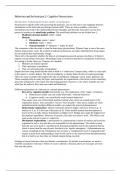Samenvatting
SUMMARY Behaviour and the Brain part 2: Cognitive Neuroscience (lectures)
- Instelling
- Vrije Universiteit Amsterdam (VU)
Summary for Behaviour and the Brain part 2: Cognitive Neuroscience based on the lectures and the lecture slides.
[Meer zien]













